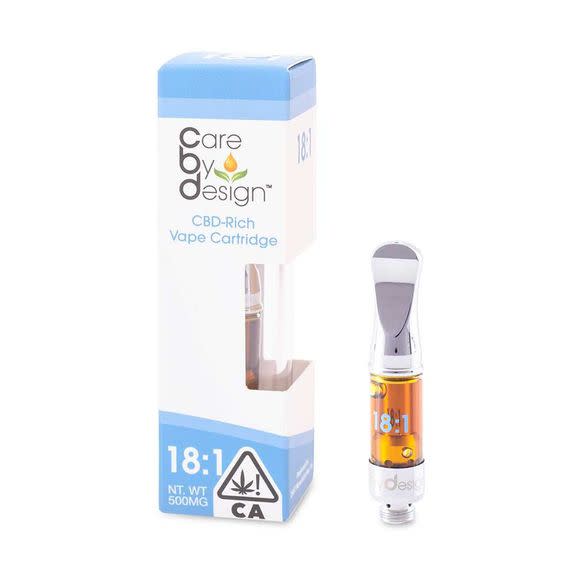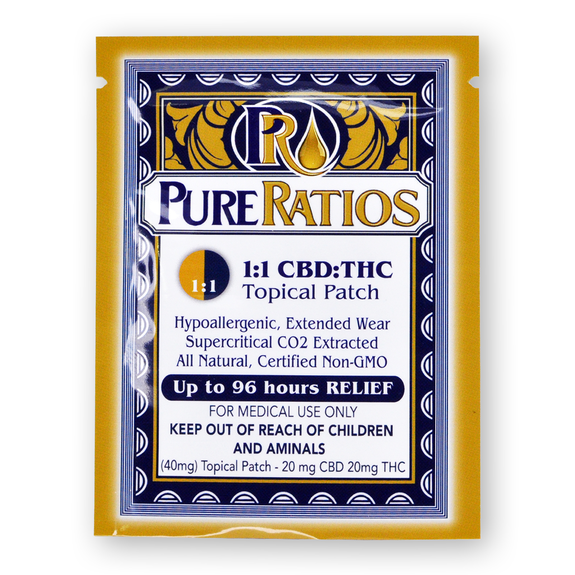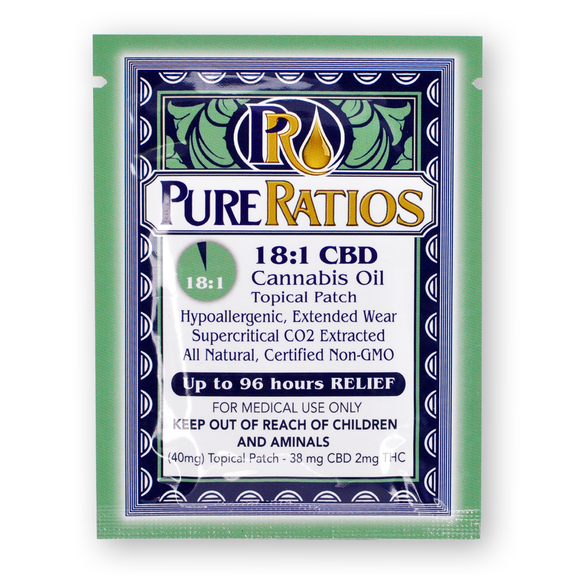Understanding the confusing world of CBD and THC ratios

This post is part of our High-tech High series, which explores weed innovations, and our cultural relationship with cannabis, as legalization in several U.S. states, Canada, and Uruguay moves the market further out of the shadows.
There's a flurry of new numbers on marijuana product labels, and the ratios can feel like a confusing math problem.
But there's a method to the madness — one based more on anecdotes than broadly recognized scientific research.
A variety of vape oils, tinctures, salves, and edibles with numbers like 18:1, 4:1, and 1:1 — noting the amount of CBD to THC — have been showing up at dispensaries in recent years in both medical and recreational states. THC will make you high, while its sister compound CBD generally won't — and has therapeutic potential. Most marijuana strains have around 18 percent THC with less than 1 percent CBD (with THC sometimes being pushed beyond 20 percent).
The cannabis companies behind the trend aren't chucking THC; they’re just flipping the ratios. For decades, growers have focused on breeding weed with increased amounts of THC. That’s still the case to a large degree, but a sliver of the market sees big things for CBD-rich marijuana products.
"They kept getting bred to go higher and higher in THC, so most strains have very low CBD," said Dennis Hunter, cofounder of Cannacraft, a Santa Rosa cannabis producer with a line of CBD-rich products under the brand name Care by Design. "Now they're starting to breed those to be higher and higher in CBD."
Care by Design, and other companies like Pure Ratios in San Diego, use previous customers' experiences to guide new users toward their preferred ratio.
But with scant evidence-backed scientific research regarding the impact of each ratio, consumers resort to trial and error to see what works for them.

Image: Care by Design

Image: Care by Design
CBD-rich products are marketed toward those seeking relief from anxiety, arthritis, seizures, stress, inflammation, and overall wellness, not necessarily a high. They're also being used to ease those once spooked off by a bad marijuana experience back in. Baby boomers are Care by Design's biggest growing customer base.
There are plenty of anecdotes from customers reporting life-changing relief with unregulated CBD-rich products, but it's still a gamble and you're the guinea pig. And these products aren't cheap. Care by Design's cartridges are $50 and its droppers are $40. Pure Ratios' droppers are around $30. CBD oil made from hemp, which has less than 0.3 percent THC, from Bloom Farms, for example, ranges from $60 to $90.
Cinnamon Bidwell, a neurobiologist at the University of Colorado Boulder's Institute of Cognitive Science, cautions not to get swept up in the testimonials promoted by cannabis manufacturers.
"The marketing and the consumer lure is far ahead of what the research can really support," said Bidwell. That seems to be the case for marijuana in general since its classification as a so-called Schedule 1 drug — which means the federal government believes it has "no currently accepted medical use and a high potential for abuse" — makes it difficult to study. Bidwell's lab, which is in a state that has legalized recreational marijuana, is conducting a 5-year study comparing the cannabinoids subjects ingest to what shows up in their bloodstreams in relation to clinical outcomes.
What's more, all the ratios can be hard to understand. Care by Design offers five (18:1, 8:1, 4:1, 2:1, and 1:1), while Pure Ratios cut down to three (18:1, 4:1, and 1:1) because customers were confused by the variety, said CEO Chad Conner.

Image: Bob Al-Greene / Mashable
Here's a rule of thumb: The higher the CBD, the less of a high you'll get from the THC, both because there's less of it and CBD generally combats THC's psychoactive effects, depending on the amount of THC you've consumed, according to cannabis researchers and producers.
When you're deciding which ratio is right for you, it'll take some experimenting. Both Hunter and Conner suggest starting with a high-level of CBD and working your way down to a more balanced product. You'll have to play around with the amount, too, but take it slow.
Care by Design sells a sampler pack to help in the guessing game. The ends of the spectrum, 18:1 or 1:1, are its best sellers; either consumers don't want to feel psychoactive effects or they do, it seems.
The trial and error, Bidwell said, is what happens when cannabis products rush into the market before there's sufficient research.
SEE ALSO: Dabbing for beginners: Confessions of a cautious concentrate newbie
There is, however, a prescription 1:1 CBD to THC mouth spray called Sativex made in the UK and available in several countries including Spain, Germany, Canada, and Brazil that's meant to treat spasms in MS patients. It's undergoing clinical trials in the U.S. Epidiolex, the first FDA-approved cannabis-derived drug in the states, is high in CBD with trace amounts of THC (not enough to have any pharmacological effect). It's used to treat seizures.
"We're starting to understand what CBD does, but even that is very minimal. And in terms of these different ratios, there's an idea or a hypothesis that there's something there in terms of THC facilitating CBD's action in a different way, if not more in different amounts. But in terms of the science being able to contribute to that in any kind of clear way, we're not there yet," Bidwell said.
Elliot Altman, biology director of the Tennessee Center for Botanical Medicine Research, disagrees with that assessment when it comes to CBD's therapeutic benefits. His lab at Middle Tennessee State University studies CBD and hemp. Marijuana isn't legal in Tennessee, but hemp is. Most CBD products are made from hemp extract, while the ratio products tend to include a variety of cannabis strains to get the right proportion.
It's clear to Altman, who does not study THC, that CBD provides relief for those with inflammatory or autoimmune conditions, but if you're looking for pain relief, that's going to come from THC. Altman's lab works with private groups looking to sell CBD from hemp as a nutritional supplement.
"THC is for pain, and CBD is for when your immune system is compromised," Altman said. His take on these emerging products is pretty simple: "If what you're really after is CBD, but you're in a marijuana state, take a little THC to take the edge off, don’t take excessive THC."

Image: Pure Ratios

Image: Pure Ratios
The National Academies of Sciences, Engineering, and Medicine put out a 2017 report surveying the scientific research done so far on the health impacts of cannabis. There is conclusive or substantial evidence that cannabis is effective in treating cancer patients with nausea, adults with chronic pain, and MS patients with spasms, according to the report. But, there's limited evidence that CBD can lessen anxiety and "no accepted standards exist to help guide individuals as they make choices regarding if, when, where, and how to use cannabis safely and, in regard to therapeutic uses, effectively."
In addition to CBD:THC ratios, the U.S. cannabis community sees a bright future for hemp-only products. The 2018 Farm Bill, which passed Wednesday, will legalize industrial hemp on the federal level once signed by the president. There are many hemp products already being sold promising calm and pain relief.
"The CBD hemp business is gonna grow way bigger. Then marijuana will take over when it's federally legal," Conner, of Pure Ratios, predicted.
And the future may have even more numbers in store.
Cannabis sellers forecast other lesser-known cannabis compounds like THCV, a possible appetite suppressant, may one day be included in ratios on packaging.
Hunter also sees powder packs of these products coming up the line — imagine Emergen-C, but with CBD. Care by Design's working on it. Coca Cola is also exploring the CBD beverage market.
"Seems like every day or week we keep finding out more and more interesting information," Hunter said.
WATCH: Is it possible to overdose on cannabis?

